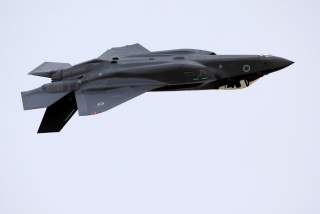The F-35 Is The Trillion-Dollar Defense Program That Can't Fail
It has a projected lifetime cost of $1.5 trillion dollars.
To be fair, Lockheed has advertised a nonstealthy “beast mode” configuration of the F-35 with sixteen wing-mounted bombs and missiles, allowing a full twenty-two-thousand-pounds payload. However, this configuration remains only hypothetical.
Payload brings us to the matter of range. Once again, the F-35 cannot rely upon externally-mounted fuel tanks if it wishes to retain its stealthy radar cross-section. In compensation, the Lightning has longer range on purely internal fuel than most fourth-generation fighters. Unfortunately, this still means that both land- and carrier-based F-35s will need to be based within range of intermediate-range ballistic missiles (IRBMs) that are quite capable of devastating airbases or sinking carriers. Mid-air refueling could help with this problem, but tanker aircraft too may be vulnerable to attack, unless the Navy chooses to acquire a stealthy tanker drone.
The Pentagon remains optimistic about the F-35’s ground-attack capabilities for a simple reason: they believe the F-35 will give it a convenient tool for penetrating increasingly deadly integrated air-defense systems without having to put together a huge strike package, including jamming planes, Wild Weasel anti-SAM aircraft, escort fighters and so forth. As discussed above, F-35s wouldn’t be invulnerable to ground-based air defenses, but they would have an easier time slipping past and dismantling ground-based missile batteries with fewer support planes put at risk.
New Paradigm of Networked Warfare
F-35 proponents also emphasize that the F-35 is designed around new digital technology to an unprecedented level. It has sophisticated sensors that not only soak up copious data from the surrounding environment, but then funnel it back for use by friendly forces via high-capacity datalinks. F-35 pilots use state-of-the-art helmets that allow them to “see through” their own aircraft (which is good, as the canopy on the F-35 has poor visibility to the rear). The F-35’s mission systems computer is designed to automatically download mission parameters, while its logistics computer can offload status reports for technicians through a proprietary encrypted system.
Thus, in the F-35, the futurists of the Pentagon envision a new networked way of war, wherein each fighter will serve as much as a sensor node for a larger war machine as it does as a distinct weapons platform.
Of the course, the flipside of seeing the F-35 as the apotheosis of a networked paradigm is that it may be more vulnerable to hacking attacks and other electronic warfare systems than any warplane before, potentially allowing for a Battlestar Galactica scenario in which a digital surprise attack leaves many of the stealth fighters compromised. Particularly unpromising is that Chinese hackers apparently broken into Lockheed’s computers twice and acquired F-35 blueprints—which may explain why China’s J-31 Gyrfalcon stealth fighter bears more than a passing resemblance to the American stealth jet.
All in all, the F-35’s rising costs and mounting delays towards achieving full operational capability have caused the Pentagon to appreciably begin downsizing or delaying F-35 orders in the near term, and advance plans on keeping the older F-15, F-16s and FA-18 in service into the 2040s. For example, the Navy now plans on phasing in two squadrons of F-35s on its carriers alongside three squadrons of FA-18 Super Hornets. One can imagine a similar force mix of F-35s cooperating with F-15s, -16s and -22s.
Rather than fully replacing the last generation of jets, the F-35 may best fit in as a complement to them by undertaking missions that take maximum advantage of its stealth characteristics and networked sensors. For example, F-35s could range ahead and ferret out the location of enemy fighters, radars and missile batteries. Then the data they gather could then be used to coordinate intercepts and attack runs by more heavily armed Eagle or Super Hornet fighters following in their wake, or even guide their missiles to their targets.
The F-35 program has long been criticized as too big to fail, and that may in fact be true given the enormous resources already sunk into it. The Pentagon, and many other countries, are betting that the new (promising but not combat-tested) air-warfare paradigm will limit the impact of its shortcomings. However, due to mounting expenses, continual delays and breakdowns, and high operating costs, the Lightning is likely to serve alongside its predecessors for a long time to come.
Sébastien Roblin holds a master’s degree in conflict resolution from Georgetown University and served as a university instructor for the Peace Corps in China. He has also worked in education, editing and refugee resettlement in France and the United States. He currently writes on security and military history for War Is Boring. This piece was first featured in April 2018 and is being republished due to reader's interest.
Image: Reuters.

